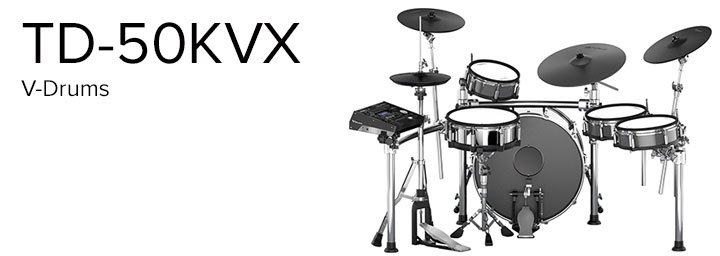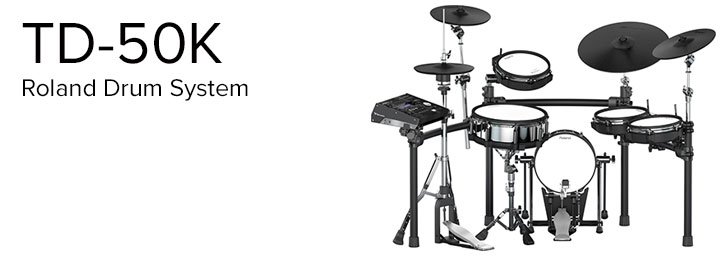Maintaining Roland TD-50 V-Drums is easy if you follow these simple steps
V-Drums offer you so many choices that you can be sidetracked sometimes!
Luckily, there are ways to streamline your setup and maintain the TD-50 V-Drums so that you can concentrate on playing.
Contributed by Simon Ayton for Roland Corporation Australia
First Things First: Keep Your TD-50 Up To Date
Check the system program version of your TD-50 and update it if it’s old.
1. Press [ SETUP ] to invoke the setup screen.
2. Use the PAGE [ UP ] and [ DOWN ] buttons to access the page where the INFO icon is located (SETUP MENU 2).
3. Press the [ F3 ] button to select the INFO icon.
4. The current version appears on the display (“Program Version”).
* If information other than Program Version is displayed, press the [ F1 ] button (PROGRAM).
5. Press the [ EXIT ] button to return to the DRUM KIT screen.
Managing your TD-50 kit patches and settings
The TD-50 features SD card storage, from which real time/full-length audio directly plays.
You can also use the SD card to store kit patches, sounds, settings and drum performance recordings made with the internal song player feature. Firstly though, here are some important things to know about maintaining Roland TD-50 V-Drums data.
Factory Preset Kits vs. User Kits
All the kit patches in the TD-50 are editable, including the factory patches, but don’t worry, the factory patches can be recalled at any time, should you want them back.
This means that there are in fact, 100 completely editable kit patches and luckily, there are clever ways of managing them.
Kit Snapshot
Before you edit a kit, you can take a snapshot of its current kit state. You can then easily revert or undo back to the original version, should you make a mistake or would like to reverse any changes you’ve made.
TIPS:
Kit Copy: When creating a new custom kit, choose a kit that is near to what you like, then copy it to another location for editing. This way, you will leave the original kit patch intact, while you work on the duplicate version. Be sure to name it accordingly.
Instrument Copy: You can copy individual pads, or even groups of instruments, e.g.: Tom 1-4 from one kit to another. This is a great way of quickly copying and pasting elements of your favourite kits together into something new, without starting from scratch each time.
Saving Kits
Individual kits appear on the SD CARD in the folder Roland/TD-50/Kit.
When editing kits in the TD-50, changes are saved automatically.
If you want to share your kits with others, you can save your entire TD-50 setup as a backup and share it. Alternatively, you can save individual kits, which can be loaded without affecting the entire TD-50 or any of the other kit patches in the module.
Saving individual kits also allows you to load the ones you need at any point and compile your own TD-50 custom setups.
If these individual kits include user samples, tick “With User Samples”. This saves the samples with the kit in one simple, self-contained file for easy loading.
Loading Kits
Individual kits appear on the SD CARD in the folder Roland/TD-50/Kit.
Kits can be loaded into any kit patch location in the TD-50.
If the loaded kit contains user samples, these will be imported into the module and will be added to the User Sample List, where they can be previewed and edited.
Once the new user samples appear in the list, they can be assigned to any trigger in any kit patch location.
Kit Chains-Kit List Creation
With 100 kit/patch locations in the TD-50, finding the next kit for the show can be fiddly in the heat of the moment if using the data wheel and +- buttons alone.
Luckily, the ‘Setlist’ feature allows you to chain up to 32 kits together, in any order you like.
You can create multiple set lists for long shows, or for grouping particular styles of kits.
Backing up the TD-50
When maintaining Roland TD-50 V-Drums, backups are a crucial step to ensure your kit data is safe and current.
These backup files contain everything to do with your TD-50, including trigger settings, system settings, set Lists and all of your kit patches. You can save multiple backups and name them individually.
Backups appear on the SD CARD in the folder Roland/TD-50/Backup.
You can overwrite backups, or create new ones each time.
Keep all your TD-50 settings safe, by regularly creating backups onto an SD Card and naming them accordingly.
If you choose the option to save user samples too, all associated sounds in the TD-50 user sample list will be saved into one single file onto the SD card, making things easy to manage.
Loading this backup file into another TD-50 will completely wipe the data off the second TD-50, so it’s important to ask first or save a backup of the TD-50’s current state, before loading your backup.
TIPS:
If you use a card reader for MAC or PC, you can copy backup files from the SD card to your hard disk for storage and safekeeping.
You may want to send a copy of the backup file to your online storage, such as DropBox or cloud server, for retrieval remotely.
Recommended Article: Mastering your sound: Making your Roland TD-50 V-Drums Sound Great








